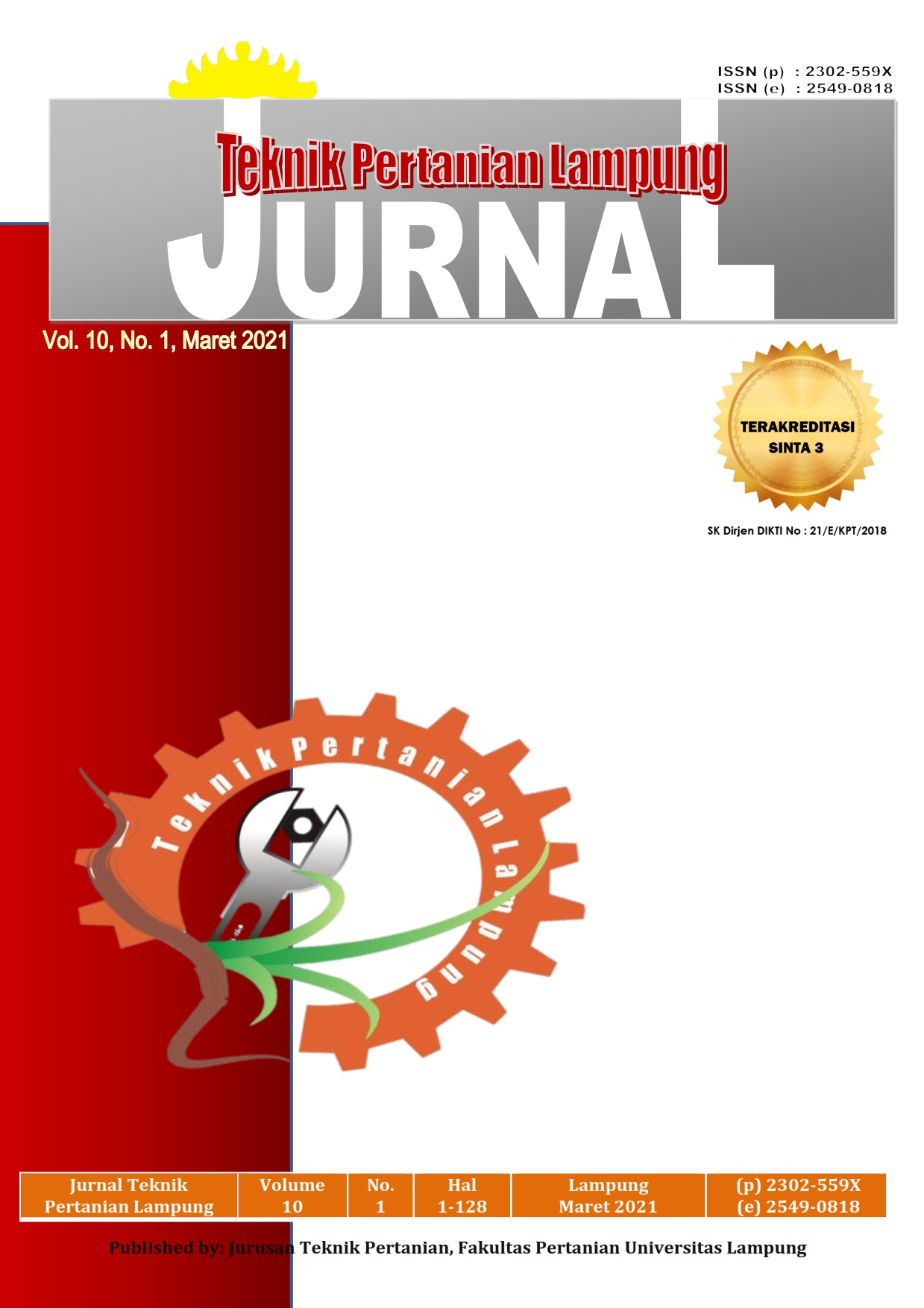PENGARUH SELEKSI FITUR CITRA TERHADAP KLASIFIKASI TINGKAT KESEGARAN DAGING SAPI LOKAL
DOI:
https://doi.org/10.23960/jtep-l.v10i1.85-95Abstract
Identifying beef manually has some drawbacks because human visual has limitations and there are differences of human perception in assessing object quality. Several researches developed beef quality assessment methods based on image feature extraction. However, not all features support for obtaining the classification results that have high accuracy. The efficiency will be achieved if the classification analyzes only the relevant features. Therefore, a feature selection process is required to select relevant features and to eliminate irrelevant features to obtain more accurate and faster classification results. One of the feature selection algorithms is the F-Score which is a simple technique that measures the discrimination of two sets of real numbers. The features with the lowest ranking from the F-Score will be eliminated one by one until the most relevant features are obtained. The test is carried out by analyzing the classification results in the form of sensitivity, specificity, and accuracy values. The results of this research showed that by using the F-Score feature, the most relevant features for the classification of freshness level of local beef are obtained using the K-Nearest Neighbor (KNN) method. These features include the average color intensity R and standard deviation with a sensitivity of 0.8, a specificity of 0.93, and an accuracy of 86%.
Keywords: Classification, Fiture Selection, F-Score, K-Nearest Neighbor, Local beef
References
Chen, Y.W. and Lin, C.J. 2008. Combining SVMs with Various Feature Selection Strategies. In Feature Extraction Book, Springer, Berlin, Heidelberg; 315-324. https://doi.org/10.1007/978-3-540-35488-8_13.
Chian, V. N., Saad, F. S. A., Ibrahim, M.F., Sudin, S., Zakaria, A., and Shakaff, A. Y. M. 2014. Meat Color Recognition and Classification Based on Color using NIR/VIS Camera. Presented at the 8th MUCET, 10-11 November 2014, Melaka, Malaysia.
Guzek, D., Glapska, D., Pogorzelski, G., Kozań, K. et al. 2013. Variation of Meat Quality Parameters Due to Conformation and Fat Class in Limousin Bulls Slaughtered at 25 to 27 Months of Age. Asian Australasian Journal Animal Science, 26(5): 716-722.
Han, J., Kamber, M., and Pei, J. 2012. Data Mining - Concepts and Techniques. 3rd Edition. Elsevier Inc., Amsterdam, The Netherland.
Kadir, A. dan Susanto, A. 2013. Teori dan Aplikasi Pengolahan Citra. Andi Offset, Yogyakarta.
Kiswanto. 2012. Identifikasi Citra untuk Mengidentifikasi Jenis Daging Sapi dengan Menggunakan Transformasi Wavelet Haar. Tesis Magister. Universitas Diponegoro, Semarang.
Omar, N., Jusoh, F., Othman, M. S., Ibrahim, R. 2013. Review of Feature Selection for Solving Classification Problems. Jurnal Information System Research and Innovation (JISRI): 64-70
Sun, X., Chen, K. J., Maddock-Carlin, K. R., Anderson, V. L., Lepper A. N., Schwartz, C. A. 2012. Predicting beef tenderness using color and multispectral image texture feature. Meat Science Journal, 92: 386-393.
Witten, I. H. and Frank, E. 2011. Data Mining - Practical Machine Learning Tools and Techniques. 3rd, Morgan Kaufmann Publisher, San Francisco.
Yudamson, A. 2017. Rerata Intensitas Warna Terpisah untuk Identifikasi Daging Kambing, Daging Babi, Daging Celeng, dan Daging Anjing. JURNAL Pengabdian Kepada Masyarakat, 23(1): 211-213.
Yulianti, T., Yudamson, A., Septama, H. D., Sulistiyanti, S. R., Setiawan, F. X. A., and Telaumbanua, M. (2016). Meat quality classification based on color intensity measurement method. In 2016 International Symposium on Electronics and Smart Devices (ISESD), Bandung, Indonesia: 248–252. https://doi.org/10.1109/ISESD.2016.7886727
Yuristiawan, D. 2015. Aplikasi Pendeteksi Tingkat Kesegaran Daging Sapi Lokal Menggunakan Ekstraksi Fitur Warna dengan Pendekatan Statistika. Riptek, 9(1): 9-16.
Downloads
Published
Issue
Section
License
- Authors who publish with this journal agree to the following terms:
- Authors retain copyright and grant the journal right of first publication with the work simultaneously licensed under a Creative Commons Attribution-ShareAlike 4.0 International Lice that allows others to share the work with an acknowledgement of the work's authorship and initial publication in this journal.
- Authors are able to enter into separate, additional contractual arrangements for the non-exclusive distribution of the journal's published version of the work (e.g., post it to an institutional repository or publish it in a book), with an acknowledgement of its initial publication in this journal.
- Authors are permitted and encouraged to post their work online (e.g., in institutional repositories or on their website) prior to and during the submission process, as it can lead to productive exchanges, as well as earlier and greater citation of published work (See The Effect of Open Access).
Jurnal Teknik Pertanian Lampung

JTEPL is licensed under a Creative Commons Attribution-ShareAlike 4.0 International License.

